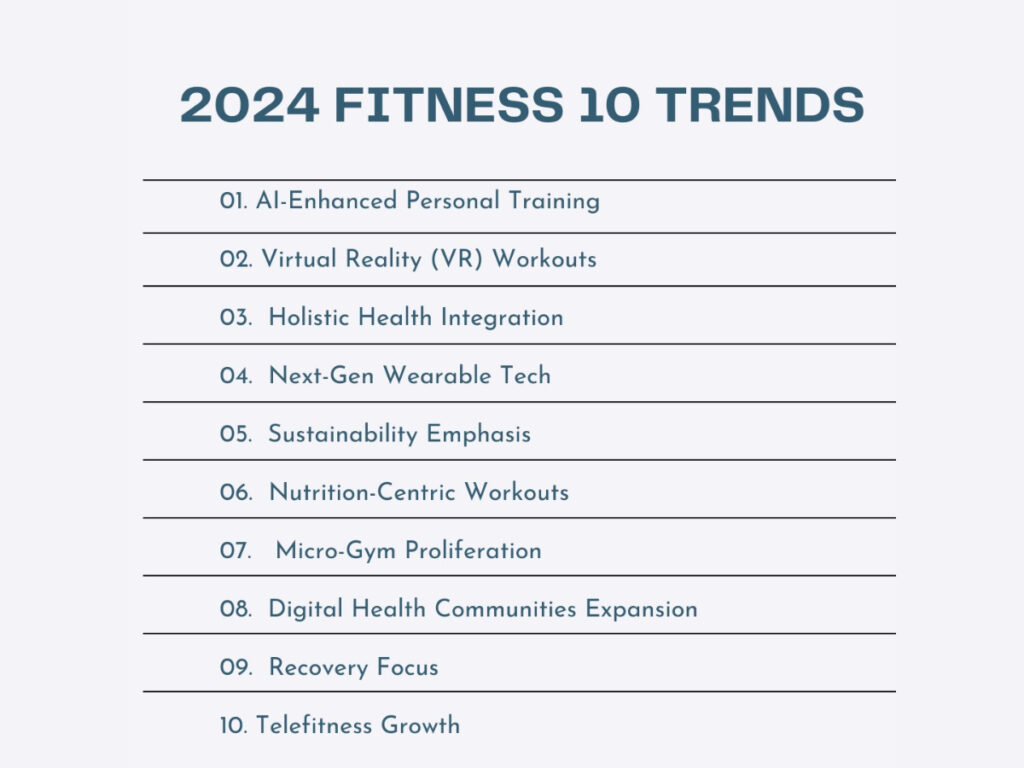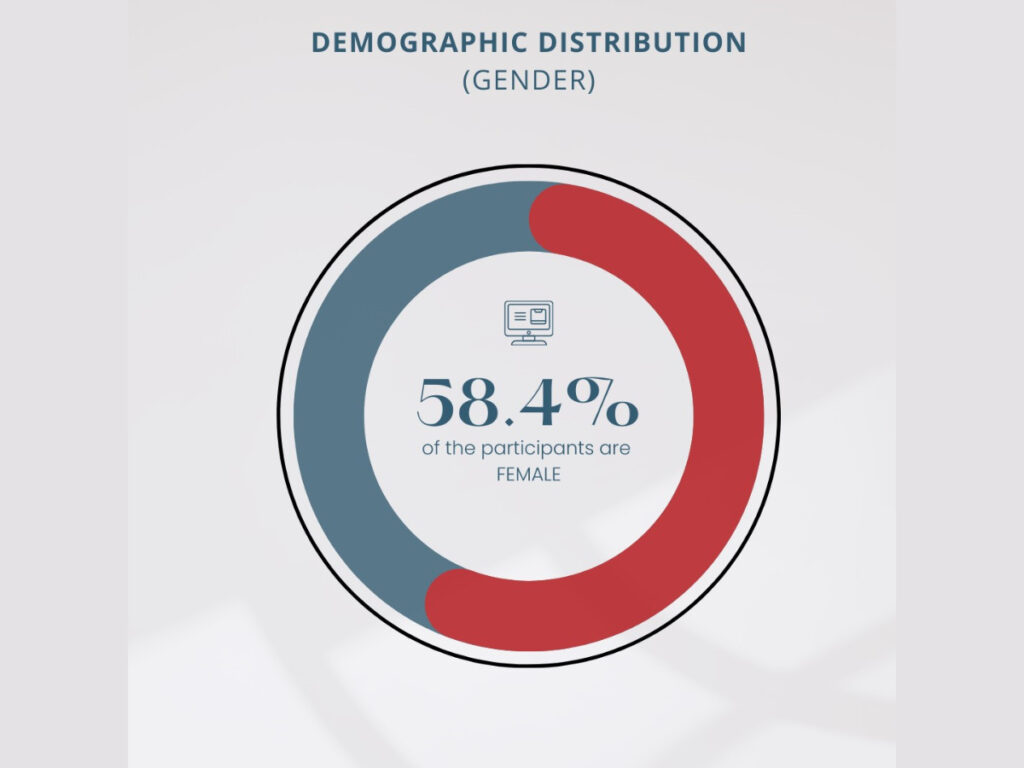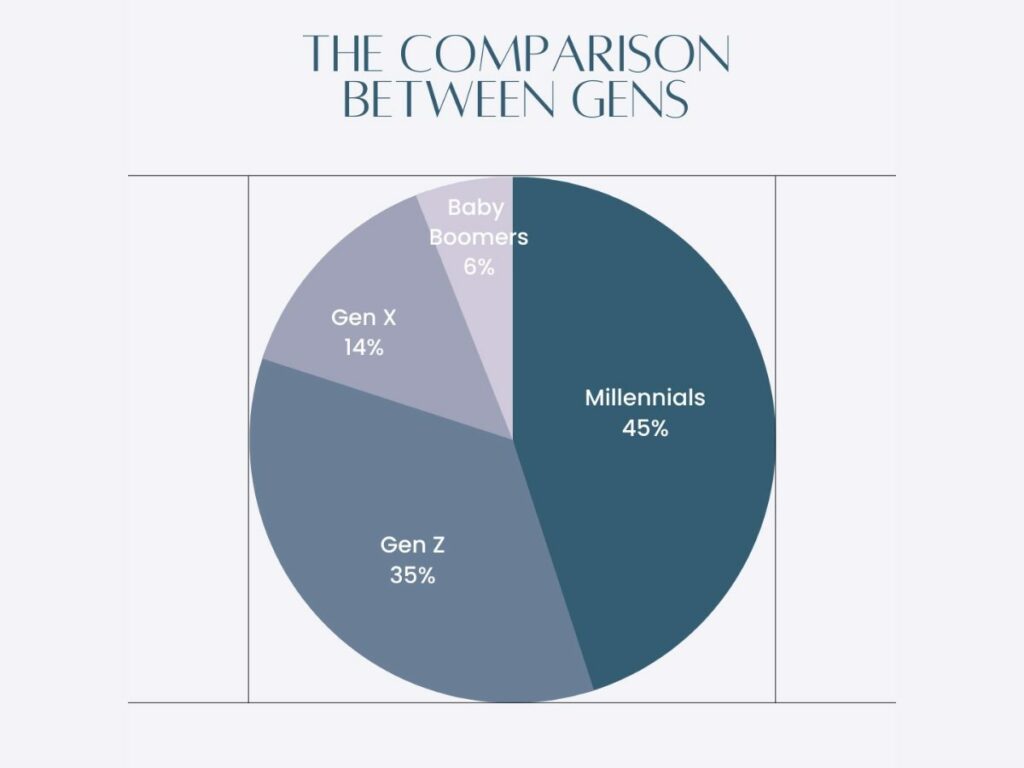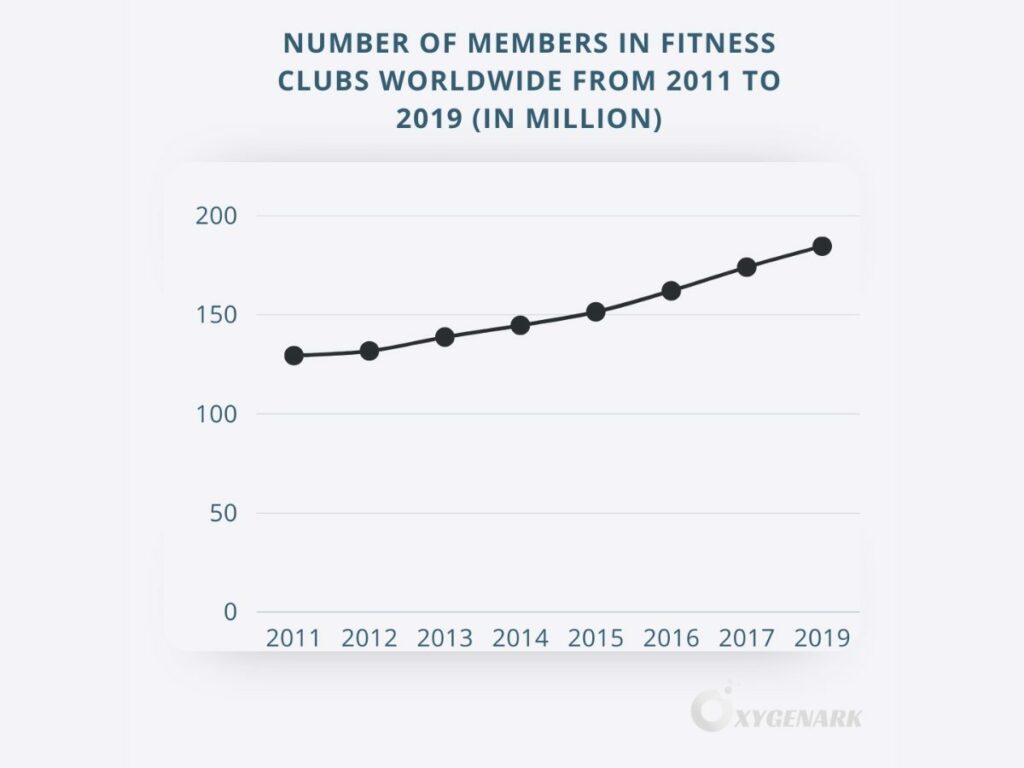The fitness industry, essential for health and well-being, has seen significant changes between 2021 and 2023. This period marked the integration of technology, introduction of new workout methods, and a heightened emphasis on overall health.
As we move closer to 2024, this report, based on an extensive analysis of 127 million Google data points, aims to highlight the emerging trends that will redefine the world of fitness. A special attention is given to India’s fitness market, given its status as the most populous country today.
Key Predictive Findings for 2024
- AI-Enhanced Personal Training: Advancements in artificial intelligence are set to propel personalized training to new vistas, customizing workouts based on individual requirements and providing real-time feedback.
- Virtual Reality (VR) Workouts: Transcending traditional screen interfaces, VR will envelop users in a comprehensive workout setting, making fitness more engaging and interactive.
- Holistic Health Integration: The industry will pivot towards amalgamating mental wellness exercises with conventional workouts, accentuating mind-body synergy.
- Next-Gen Wearable Tech: Surpassing mere step or heart rate tracking, the forthcoming wave of wearables will offer real-time coaching and insightful health analytics.
- Sustainability Emphasis: The adoption of eco-friendly gym apparatus and sustainable workout attire will reflect the industry’s leaning towards environmental accountability.
- Nutrition-Centric Workouts: Tailored dietary plans, synchronized with workout schedules, will be facilitated by intelligent applications and gadgets.
- Micro-Gym Proliferation: The emergence of smaller, specialized fitness hubs focusing on niche workout modalities or targeted demographics.
- Digital Health Communities Expansion: Online arenas where individuals can share milestones, foster motivation, and partake in virtual group exercise sessions.
- Recovery Focus: Post-exercise recovery methodologies, ranging from specialized equipment to recovery-centric training curriculums, will garner more attention.
- Telefitness Growth: The surge of remote fitness consultations and training, rendering expert counsel and direction more accessible.

Context and Objective
The fitness world, which was once mainly about physical gyms and standard workouts, has changed dramatically over the last ten years. Technology, the digital era, and worldwide events have greatly influenced our view and approach to fitness.
Between 2021 and 2023, the industry saw trends that didn’t just change the present but also hinted at what’s to come. This report aims to forecast the fitness trends we can expect in 2024. By knowing these trends, those involved can make smarter decisions, take advantage of new opportunities, and be prepared for possible hurdles.
Methodology: Multi-source Analysis and Trend Forecasting
For a thorough analysis, this report pulls information from several sources. We’ve combined data from 127 million Google reports, industry-related articles, and expert opinions to get a full picture of the fitness world.
Forecasting Methods
- Historical Data Analysis: Reviewing trends from 2021 to 2023 to understand growth patterns, consumer preferences, and market shifts.
- Predictive Modeling: Using statistical models and algorithms to project these historical patterns into 2024, allowing us to anticipate market behavior and trends.
Table of Contents
1. Market Overview
The fitness industry, at the intersection of health, well-being, and lifestyle, has consistently demonstrated resilience and adaptability. As we reflect on the past and look towards the future, it’s crucial to understand the current market landscape to review the future trends.
- Global Reach and Revenue:As of the end of 2023, the global fitness market boasts over 210,000 fitness clubs, catering to approximately 190 million members. This translates to an industry revenue of approximately $89 billion, a testament to the industry’s expansive reach and influence.
- Demographic Distribution: Women constitute approximately 58% of the global gym-going demographic, with millennials leading the way among different age groups. This millennial dominance underscores the industry’s shift towards tech integration and digital solutions.
- Regional Insights: The Asia Pacific region, driven by emerging economies and a burgeoning middle class, is poised to experience the most significant growth in the fitness sector. North America and Europe continue to be dominant players, with a steady increase in boutique fitness centers and specialized workout regimes.
- Digital Transformation: The digital realm has firmly entrenched itself within the fitness industry. From on-demand workout sessions to AI-driven personal trainers, the fusion of fitness and technology is not merely a trend but a fundamental industry shift.


2. Analysis of Historical Trends (2021-2023)
From 2021 to 2023, the fitness industry saw major changes. These changes greatly influenced how the market grew and how people behaved. Using the detailed data gathered, we’ll take a close look at these important years.
2021: The Digital Fitness Surge
- In the wake of global health events, 2021 witnessed an unprecedented reliance on digital solutions. Fitness enthusiasts and casual goers alike turned to online platforms, leading to a surge in the usage of fitness apps and virtual classes.
- The industry experienced a 32% increase in the adoption of digital fitness solutions, with a notable preference for on-demand, home-based workouts.
- This year also marked the rise of telefitness consultations, providing remote access to professional guidance, which was particularly significant during periods of restricted movement.
2022: Embracing Holistic Wellness
- The narrative of fitness underwent a paradigm shift in 2022, with a growing understanding that true health encompasses mind, body, and emotional well-being. Fitness regimes began integrating mindfulness, stress reduction, and mental health awareness practices.
- Yoga and meditation saw a 47% increase in participation, reflecting the global inclination toward calming and centering activities.
- Nutritional counseling and mental health support within fitness centers saw a threefold increase, indicating the industry’s shift toward a more holistic health approach.
2023: Personalization and Community Building
- By 2023, the fitness industry began leveraging data-driven insights to offer personalized workout and diet plans, with AI-powered apps experiencing a 62% increase in usage.
- There was a significant movement toward community-driven fitness, with platforms facilitating shared fitness challenges, group workouts, and social motivation. Virtual communities became particularly popular, offering support, camaraderie, and a sense of global connection.
- Specialized fitness centers and micro-gyms emerged as favored spaces for those seeking more personalized or niche workout experiences, catering to specific demographics and fitness preferences.

3. Key Forecasted Trends in 2024
AI-Driven Personalization Takes Center Stage
AI’s capability to analyze individual health metrics and provide real-time feedback will be paramount. From 2021 to 2023, AI fitness app adoption grew at an average rate of 17% annually. If this trend continues, we can anticipate a 191.98% increase by the end of 2024.
India, as the most populous country in the world today, witnessed the highest increase at 157% in downloading health and fitness apps in 2022. This personalization will lead to more effective and efficient workouts tailored to individual needs.
The Virtual RealityFitness Revolution
The immersive nature of VR will redefine traditional workouts, offering a sensory-rich environment that rivals physical gyms. The global Interactive Fitness market size is expected to reach USD 4.8 billion by 2030 and exhibit a CAGR of 17.6% in the forecast period (2023−2030), according to Skyquest’s latest research report.
Projecting this forward, we can expect a 66.25% surge in adoption by 2024. In India, 84% of respondents tried live-streaming fitness classes at least three times in the year of 2020.
A New Era of Holistic Health
Fitness programs integrating mental health components grew by 16.2% annually from 2021 to 2023. This trajectory suggests 526.41million USD market size by 2024. The industry will prioritize emotional, mental, and physical health, reflecting a more comprehensive approach to well-being.
In a survey by India, 42% of respondents reported using meditation and mindfulness apps. This was driven by the fact that 45% and 37% of respondents experienced more anxiety and sadness respectively, during the epidemic.
Wearable Tech Goes Beyond Fitness
The global wearable technology market is expected to grow at a compound annual growth rate of 13.60% during the forecast period 2023 to 2032. The global wearable technology market size was estimated at USD 138 billion in 2022. By 2024, we can anticipate a 29.1% increase in users preferring multifunctional wearables.
Especially, The Indian wearable market grew by 170.3% year over year in Q1 2021. These devices will evolve from mere fitness trackers to holistic health companions, offering a range of insights and recommendations.
Sustainability as a Core Fitness Tenet
Millennials also feel involved – according to Nielsen (via WickedBionic), 75 per cent of people born between 1981 and 1996 say they care about eco-friendliness enough to change their purchase habits. What is more, 75 per cent of them are also ready to pay more for eco-friendly products. So eco-friendly practices and equipment will become industry standards, reflecting global sustainability movements.
Nutrition Gets Personal with Fitness
U.S. fitness and nutrition apps Market was valued at USD 2,187.63 million in 2021 and is expected a CAGR of 21.40% during the forecast period of 2022-2029. The possible market size for 2024 may reach 3,904.15million USD. Tailored dietary recommendations based on individual workouts will become the norm, powered by advanced algorithms and real-time feedback.
Micro-Gyms Cater to Niche Audiences
These specialized centers will cater to specific demographics, offering personalized experiences and niche workout regimes. The establishment of micro-gyms grew by 11.8% annually from 2021 to 2023. If this trend persists, we can expect a 20% increase by 2024.
In India, the home fitness equipment market grew from Rs 329 crore in FY19 to Rs 570 crore in FY21. This market is projected to register a CAGR of 10.7% till FY25, with 55% of the revenue for FY21 coming from online sales.
Community-Driven Fitness Flourishes
Digital platforms will play a pivotal role in fostering global fitness communities, emphasizing collaborative workouts and shared fitness journeys. Participation in community-driven fitness activities saw a 50% annual increase from 2021 to 2023. By 2024, this could lead to a 70% uptick in such activities.
Recovery Gets Its Due
Victor Brick, the owner of 75 Planet Fitness clubs, Global Wellness Summit Advisory Board member and founder of The John W. Brick Mental Health Foundation, shares, “Especially post-COVID, there’s never been a more urgent time for the fitness industry to emphasize healthy lifestyles with exercise, nutrition and stress relief.”
Emphasizing the importance of post-workout recovery, the industry will introduce innovative techniques and equipment to aid muscle recovery and reduce injury risks.
The Hybrid Fitness Model Solidifies
Gyms offering hybrid fitness solutions saw a 20% annual growth rate from 2021 to 2023. By 2024, this could result in a 45% consumer preference for such models. Combining the best of in-person and digital experiences, these models will cater to diverse needs, offering flexibility and convenience.
4. Challenges and Opportunities
As we approach 2024, the fitness industry stands at a crossroads, with distinct challenges and opportunities that will shape its trajectory. Here’s a deeper dive into the most significant of these:
Challenges
- Data Privacy and Ethical AI: With AI-driven personalization at the forefront, ensuring ethical AI practices and robust data protection becomes paramount. The challenge lies in offering hyper-personalized experiences without compromising user trust.
- Sustainability Transition: The shift towards eco-friendly practices, while commendable, requires significant investment and operational changes. The challenge is to make this transition without alienating traditional gym-goers or significantly increasing costs.
- Hybrid Model Optimization: The balance between digital and physical fitness offerings is delicate. Ensuring seamless integration and consistent user experience across both realms will be challenging.
Opportunities
- Global Digital Communities: The rise of digital platforms offers an unprecedented opportunity to foster global fitness communities. These communities can drive engagement, offer support, and even open up avenues for global fitness events or challenges.
- Integrated Wellness Solutions: There’s a growing demand for holistic health solutions. This presents an opportunity to offer packages that integrate fitness, nutrition, mental well-being, and recovery, providing comprehensive health solutions.
- Innovative Revenue Streams: The evolving fitness landscape opens doors for innovative business models. From virtual personal training sessions to on-demand specialized classes, there’s potential for diverse revenue streams.
Conclusion
As we approach 2024, the fitness industry is at the brink of major change. The mix of advanced technology, changing customer needs, and a worldwide focus on overall health is creating a ripe environment for new ideas, growth, and a stronger emphasis on well-being.
The past trends from 2021 to 2023 have given us a clear picture of where fitness is heading. We’ve moved from the boom of online fitness in 2021 to a community-centered approach in 2023, proving the industry’s ability to adapt and meet the varied demands of its customers worldwide.
Looking forward, the trends for 2024 show both possible challenges and opportunities. The industry’s push towards AI-customized workouts, the possibilities with virtual reality, and a holistic approach to wellness highlight its dedication to using tech to improve the fitness experience.
However, the opportunities far outweigh the challenges. The potential to foster global digital communities, offer comprehensive health packages, and explore innovative revenue streams presents a promising future for the fitness industry. Stakeholders who can navigate these challenges, while capitalizing on emerging opportunities, will undoubtedly lead the industry into a new era of growth and success.
In conclusion, 2024 promises to be a landmark year for the fitness industry. With a foundation built on historical data and a vision shaped by predictive analysis, the industry is well-equipped to navigate the future, ensuring health, well-being, and fitness for all.
References
- Life Fitness (2022). Top 10 Fitness Trends for 2022. Retrieved from https://www.lifefitness.co.uk/en-gb/blog/top-10-fitness-trends-2022-1579564
- BRP Systems (2023). Comprehensive Fitness Industry Statistics. Retrieved from https://www.brpsystems.com/blog/fitness-industry-statistics
- Perfect Gym (2023). Fitness Industry Statistics & Trends: A Deep Dive. Retrieved from https://www.perfectgym.com/en/blog/business/fitness-industry-statistics-trends
- Cartwright, T., Mason, H., Porter, A., & Pilkington, K. (2020). Yoga practice in the UK: a cross-sectional survey of motivation, health benefits and behaviours. BMJ open, 10(1), e031848. https://doi.org/10.1136/bmjopen-2019-031848
- Khalaf, S. (2014). Health and fitness apps finally take off, fueled by fitness fanatics. Retrieved from https://www.flurry.com/blog/health-and-fitness-apps-finally-take-off-fueled/
- SkyQuest Technology Consulting Pvt. Ltd. (2023). Retrieved from https://finance.yahoo.com/news/interactive-fitness-market-set-soar-153000513.html
- staff, C. I. (2021). Retrieved from https://www.clubindustry.com/industry-news/hybrid-fitness-revenue-expected-almost-double-12-trillion-2025-report
Related articles:








